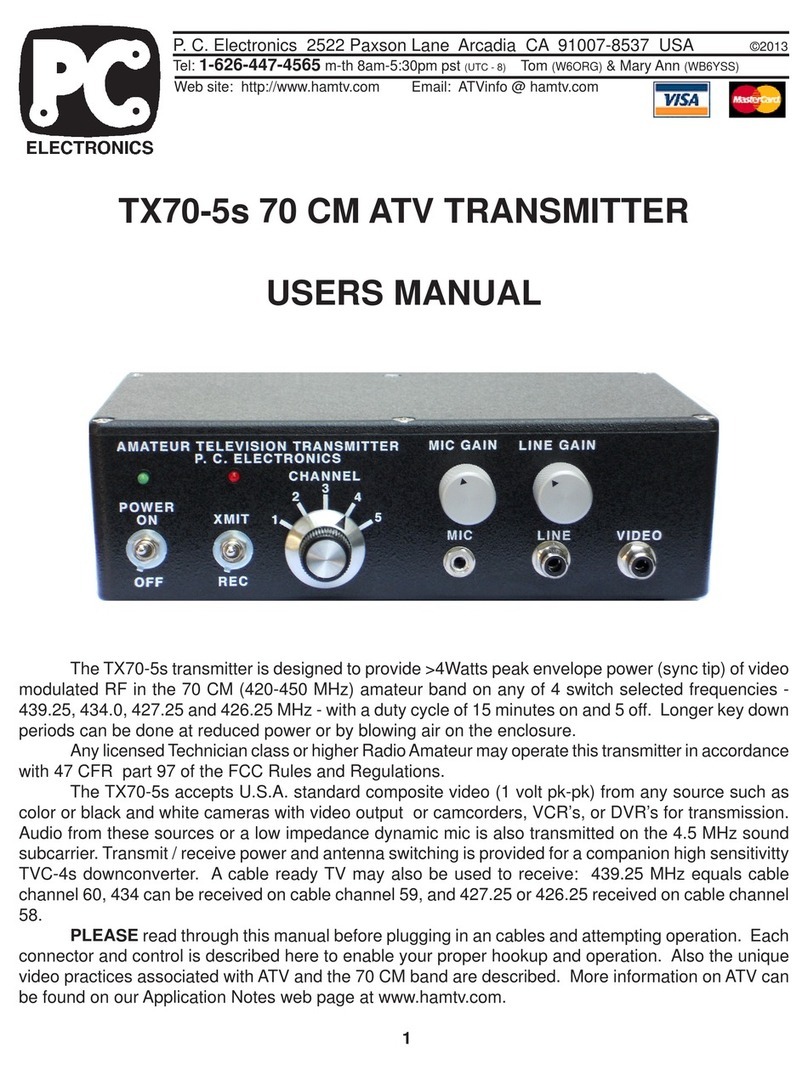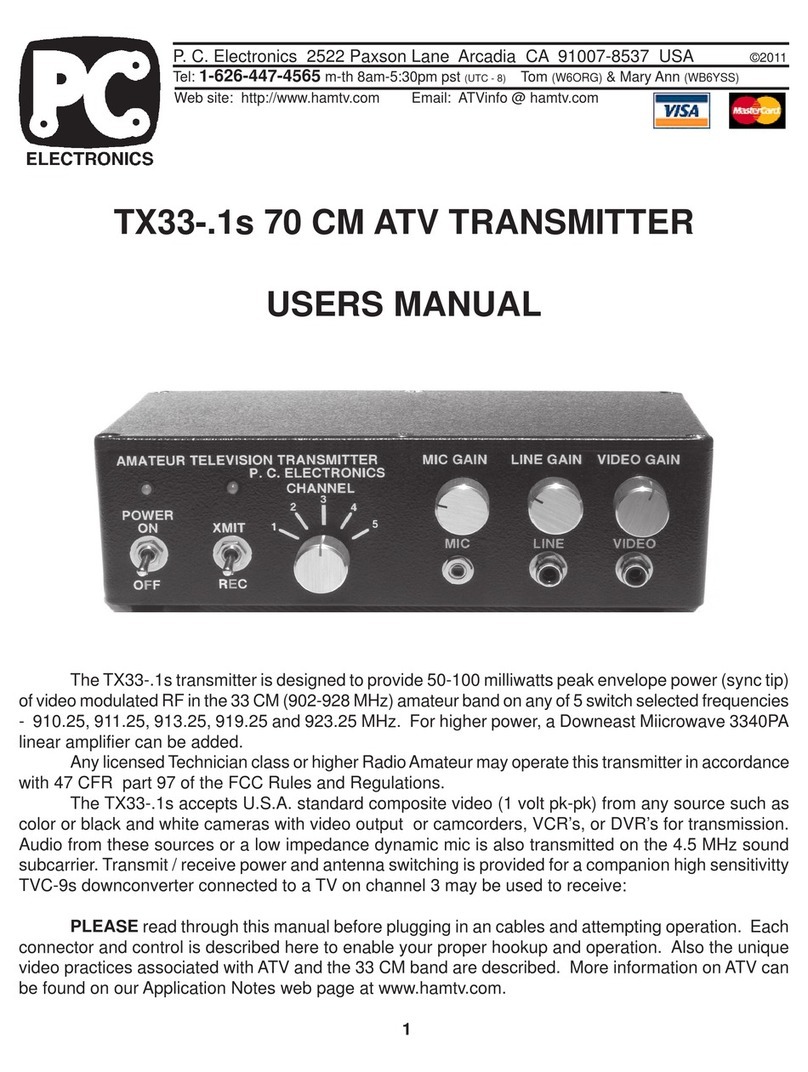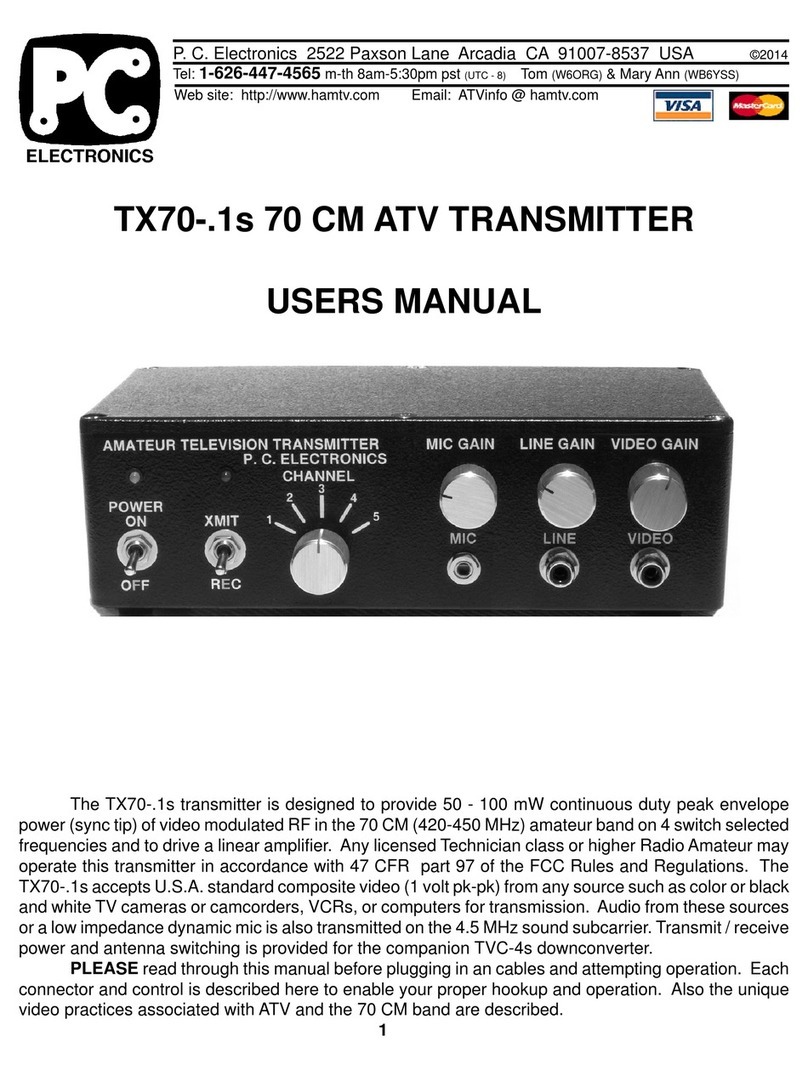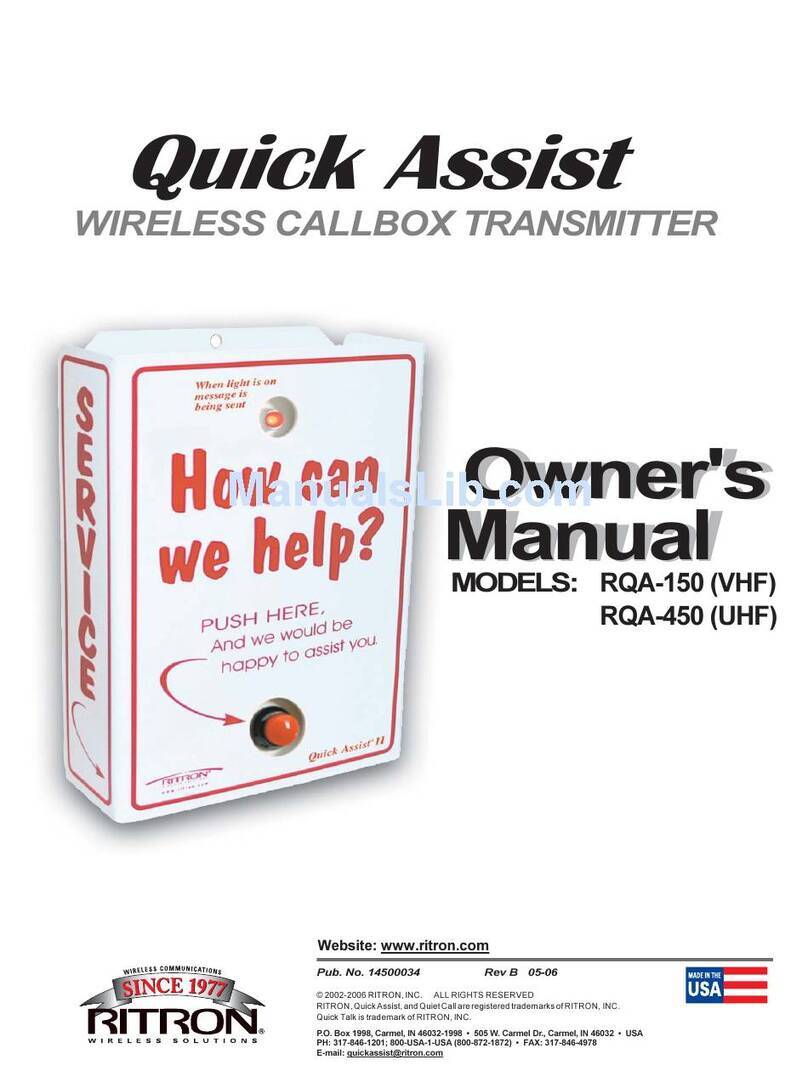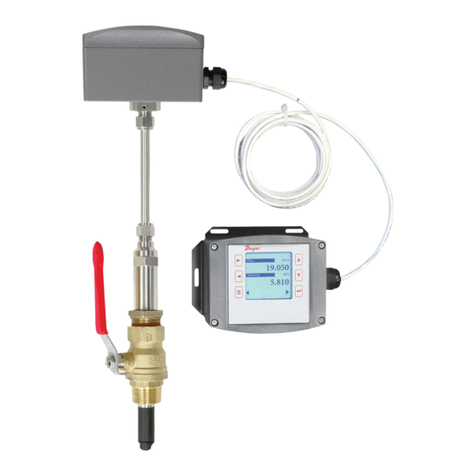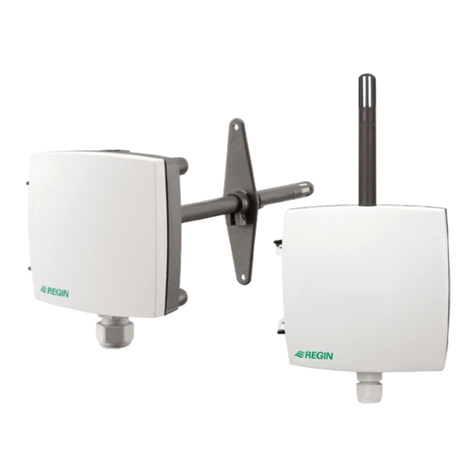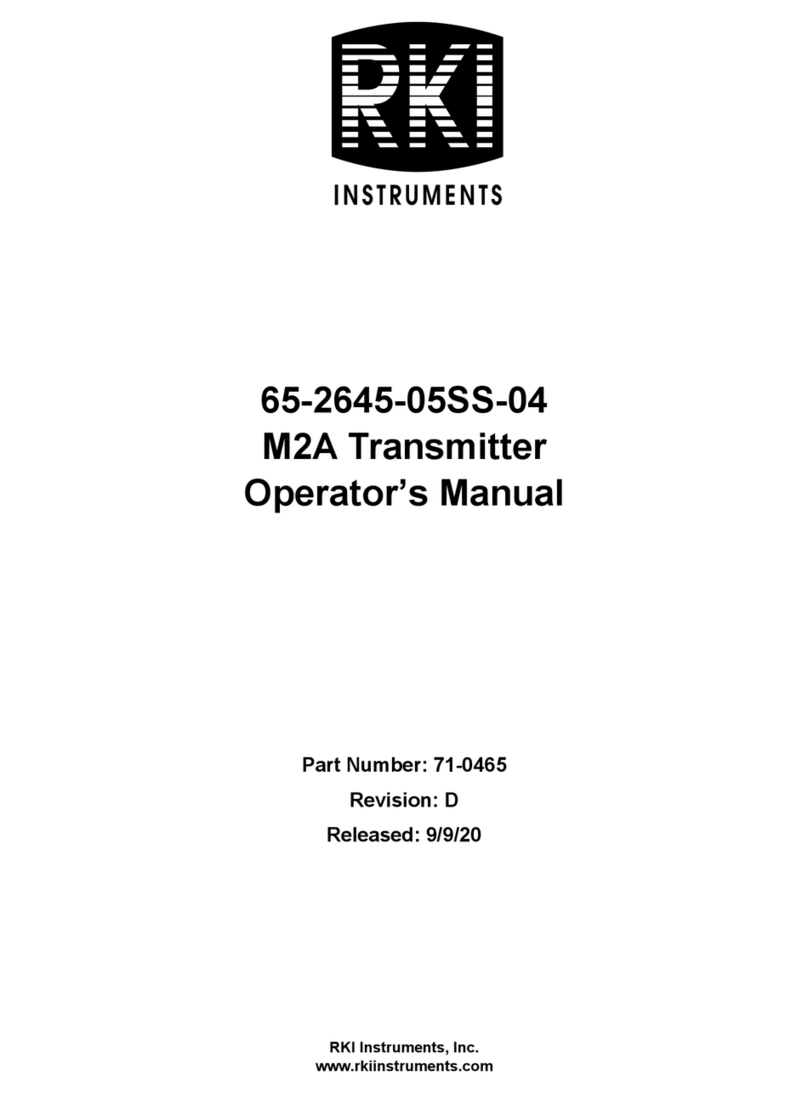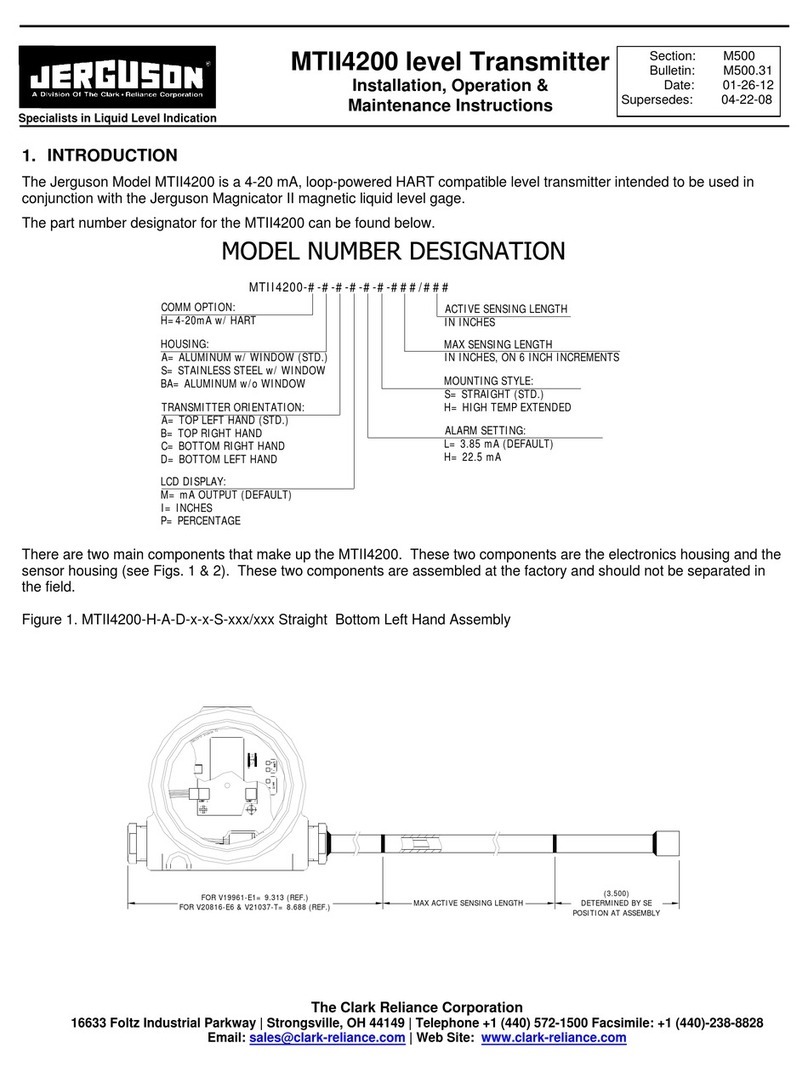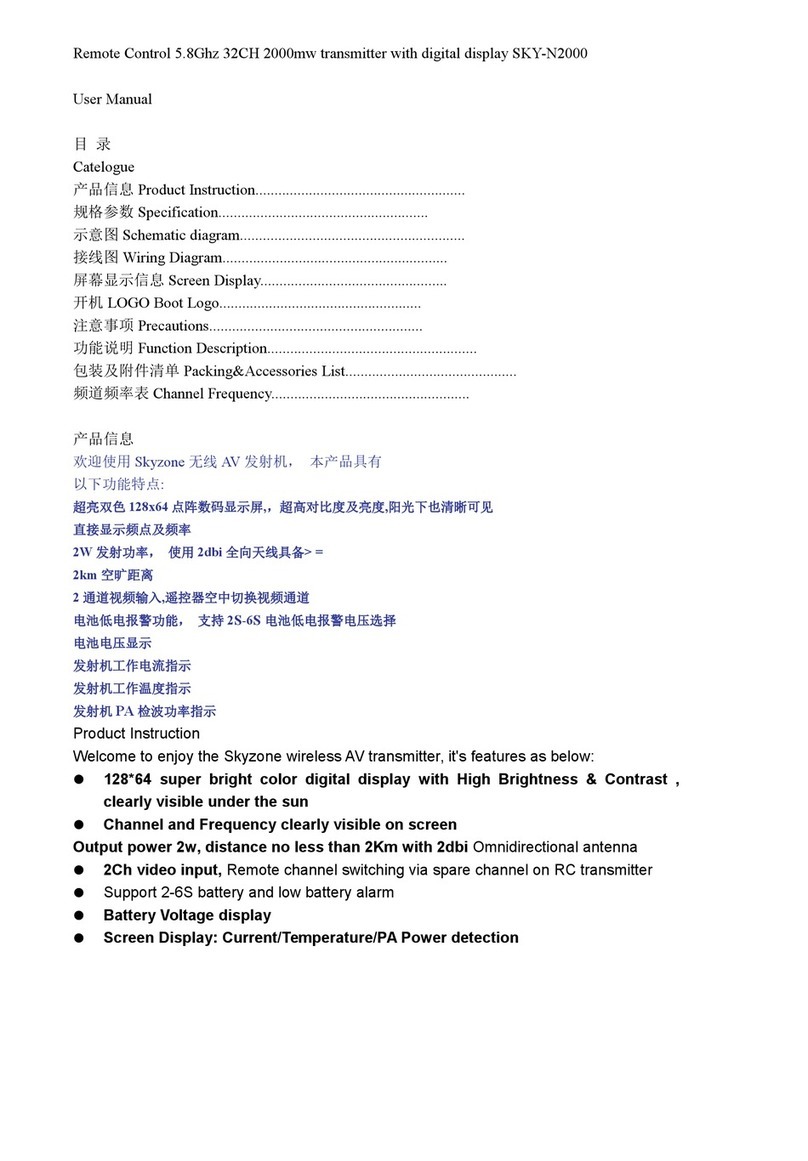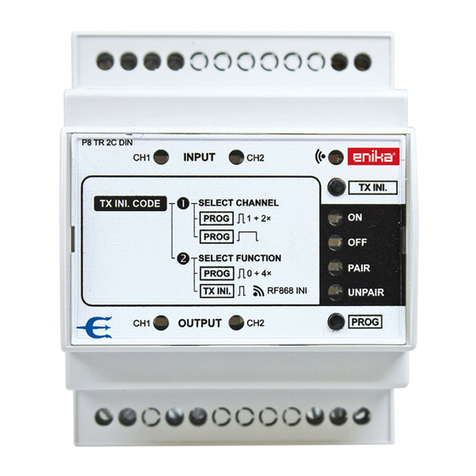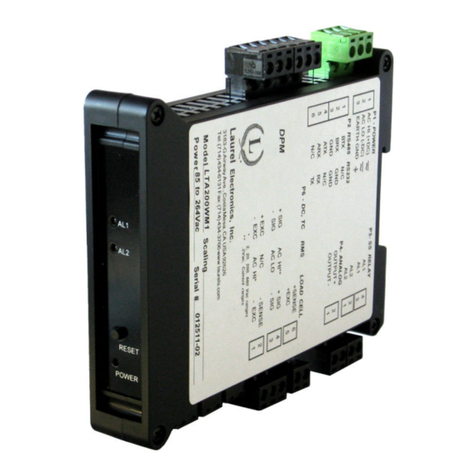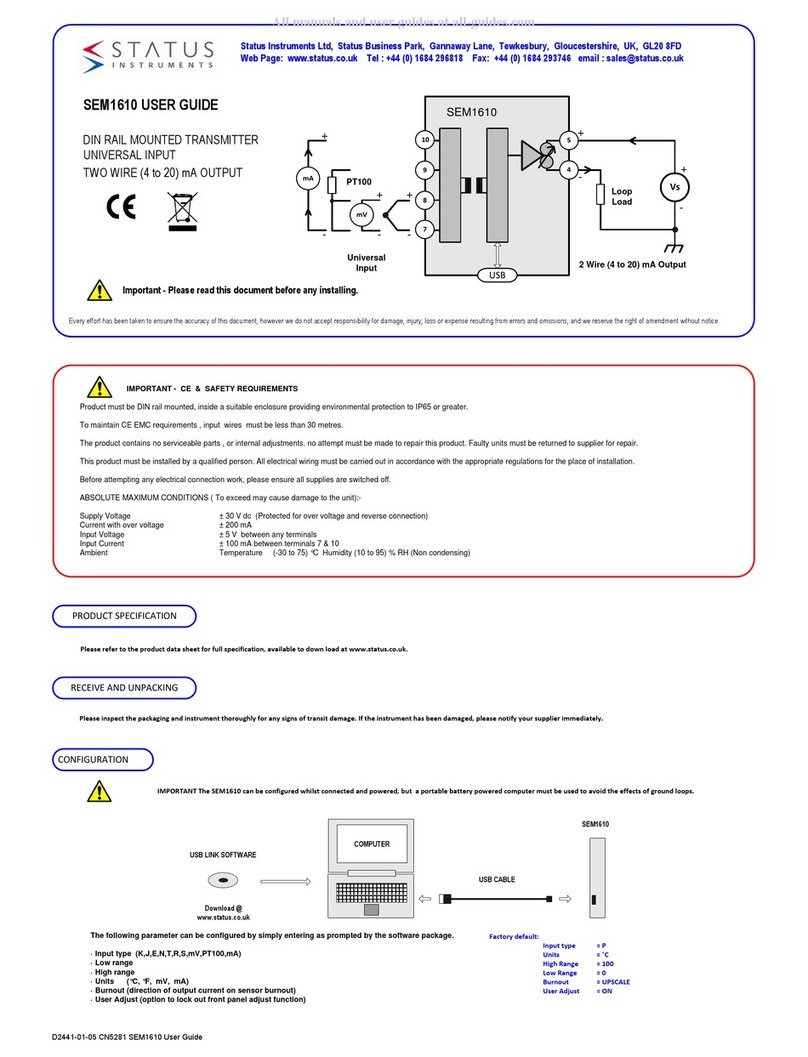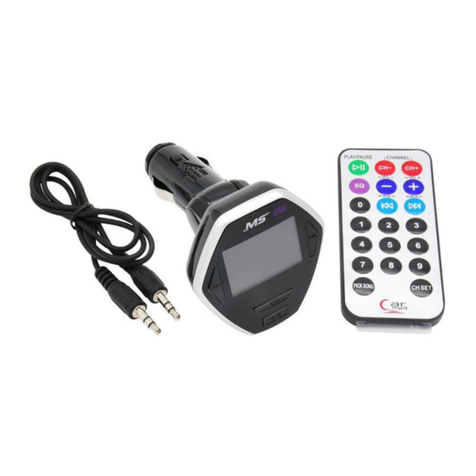PC Electronics TX70-5 70 User manual

P. C. Electronics 2522 Paxson Lane Arcadia CA 91007-8537 USA ©2009
Tel: 1-626-447-4565 m-th 8am-5:30pm pst (UTC - 8) Tom (W6ORG) & Mary Ann (WB6YSS)
Web site: http://www.hamtv.com Email: ATVinfo @ hamtv.com
TX70-5 70 CM ATV TRANSMITTER
USERS MANUAL
The TX70-5 transmitter is designed to provide over 0-5 Watt continuous duty peak envelope
power (sync tip) of video modulated RF in the 70 CM (420-450 MHz) amateur band. Any licensed
Technician class or higher Radio Amateur may operate this transmitter in accordance with 47 CFR part
97 of the FCC Rules and Regulations. The TX70-5 accepts U.S.A. standard composite video (1 volt pk-
pk) from any source such as color or black and white TV cameras or camcorders, VCRs, or computers
for transmission. Audio from these sources or a low impedance dynamic mic is also transmitted on the
4.5 MHz sound subcarrier. Transmit / receive power and antenna switching is provided for the compan-
ion TVC-4S downconverter.
PLEASE read through this manual before plugging in an cables and attempting operation. Each
connector and control is described here to enable your proper hookup and operation. Also the unique
video practices associated with ATV and the 70 CM band are described.
1
W6ORG ©2009

REAR PANEL:
POWER INPUT JACK. A 4 pin plug and 3 ft long #18 cable
is provided for connection to your source of +12 to14 Vdc.
Currant draw is 500 MA in transmit. Pin 1 is ground (black)
and pin 2 (red) is +. The TX70-5 works best from a well
regulated voltage source with leads no longer than necessary.
The transmitter is set up by us from a regulated 13.8 Vdc
supply. Do not exceed 15 Vdc input. There is a 16 v zener
which should blow the fuse if this voltage is exceeded or the
supply leads get cross connected, but semiconductors have
been known to protect fuses. If a new fuse immediately blows
again, check and replace the 1N4745B 16V zener located
near the fuse holder inside.
Any ripple or noise on the DC line may be seen in the
transmitted video. For this reason, if a single large power
supply is used to power this and other equipment, all leads
must connect directly at the power supply terminals, not to
an external terminal block. If a 50 or 70 watt amp is added,
it is best to run it from its own separate power supply. A
Radio Shack 13.8 Vdc 3A regulated power supply will run
both the TX70-5 and TVC-4S.
Pin 4 has the applied + voltage when the T/R switch is in
the receive position in order to power an ATV downconverter
such as the TVC-4S. Pin 3 is ground. If a TVC-4S is used,
the wall plug supply may be disconnected and a two wire
cable made up to run from pins 3 and 4 to the 2.1mm jack.
Take care to insure that the tip of the power plug is connected
to the positive voltage on pin 4 of the TX70-5 power input
jack, and that there are no adjacent pin shorts in the 4 pin
plug with an ohm-meter before reinserting into the TX70-5.
1 AMP FUSE INSIDE. The TX70-5 itself draws about 1.5
amp in transmit, and .1 amp plus external downconverter in
receive - a 2 or 3 amp 3AG fuse should handle both.
TO MONITOR. This output provides camera video during
receive periods to enable you to best adjust focus and
lighting, etc., rather than a distant station describing these
back to you on 2 meters. Use a RCA plug shielded cable to
connect to your video monitor or VCR video in. If you do not
have a video monitor, the Radio Shack 15-1273 RF Modulator
can take the composite video and modulate it up to channel
3 or 4 to make a second TV set into a monitor. Attempting to
monitor off the air with another TV set at the same QTH most
often gives false indications due to overload and reflections.
Even receiving the 2nd harmonic 40 or more dB down around
channel 80, or on cable channels between 57 and 60 can
give an erroneous indication of transmitted picture quality.
50 OHM 70 CM ANTENNA. A UG21 type N plug is pro-
vided to attatch to low loss .5" size 50Ωcoax. Losses at 70
CM are very high in transmission lines. We suggest using
the foam filled types (3.5 dB/100') such as Belden 8214, or
semi rigid (2.5 dB/100') Belden 9913. Put the connector
together properly. See ARRL HandBook Chapter 37. The
type N connector has good moisture resistance and low loss
at UHF but use two layers of vinyl tape or coax seal on all
outside connections to prevent moisture contamination. The
antenna and feed line are the most important part of your
ATV system, and therefore the last item to just try and get by
with.
Take great care with preparing connectors and cable. On
initial turn on, do not transmit more than 10 seconds if the
reflected power is more than 10% or 2:1 VSWR. You could
damage the VM-70X module. Also, VSWR or being too near
your antenna can cause RF interference in your camera or
buzz in the audio. With no video connected, the RF power
meter should read between 4 to 5 Watts sync tip, p.e.p.,
power.
Use a good resonant broad bandwidth 70 CM antenna.
Do not be tempted to just try it out with a rubber duckie, 2
meter antenna, or other antenna not specifically designed
for the video carrier frequency. Place the antenna as high
as practical, at least above the trees or roof tops. See the
section on dx vs. power vs. gain on page 4.
TO DOWNCONVERTER. This BNC output jack is connected
to the antenna input of your 70 CM 420-450 MHz ATV down-
converter. Downconverters for other bands are not connected
to the TX70-5, rather to their own antenna and left on when
transmitting on 70cm for full duplex or crossband repeat. If
a TVC-4S downconverter is used you will need a short 50
Ohm cable with a male BNC on one end and type N on the
other. This can be made up with Radio Shack RG58/U (276-
1326) plus UG88 (278-103) and N (278-151) connectors or
equivalent. Keep this lead short to minimize losses in receive.
The TX70-5 contains a T/R relay to switch the antenna input
between the downconverter and the transmitter. See the
Power Input Jack paragraphs two and three for power
connections.
VIDEO INPUT. This input accepts any standard NTSC
composite video into 75Ωfrom cameras, VCRs, computers,
SSTV or RTTY converters, home satellite converters, etc.
Use RCA phono plug and shielded cable (Radio Shack 15-
1535) up to 12' or RG59 for longer runs.
FRONT PANEL:
2

LINE AUDIO INPUT. High level line audio usually from the
same source as plugged into the companion Video input is
plugged into this jack using another RCA phono plug shielded
cable. Minimum level is .1 v pk-pk into a 10K load. The level
is controlled by the line audio gain knob.
LINE AUDIO GAIN control. Nominal input is .1 to 1 Vp-p
into 10K. Increase the line or mic audio gain controls to the
point that the green LED blinks off (indicating that the AGC
limiting at 25 to 40 kHz), and then back off a little. In the off
position, the whole sound subcarrier board is turned off.
MIC jack accepts any low Z dynamic or low Z Amplified
electret camcorder mic in the range of 100 - 600 Ohms with
a mini plug. Mic audio is active at all times and mixes with
the camera or external audio inputs to enable greater pickup,
commenting while running video tapes, etc. Mikes must have
a shielded cable to prevent RF pickup hum and buzz. Some
electret and amplified mics are very susceptible to RF pickup
and may need the addition of a small 220 pF disc cap (RS
272-124) directly across the mic element. Presently Radio
Shack makes 2 different replacement remote-control dynamic
omnis for portable recorders (33-2001 & -1067) that work
well and some provide the “push to look” plug also. The 33-
2001 has a wind screen which is preferred for portable work.
The unidirectional 33-3015 or 33-3021 is used for full duplex
to minimize speaker feedback.
PTL submini jack. Push To Look is like push to talk only with
video. Grounding the tip keys the transmitter. This jack is in
parallel with the front panel transmit/receive toggle switch.
MIC GAIN control sets the level from the low impedance mic
jack. This audio is mixed with the line audio and its level is
varied independantly. If you connect the audio from your
home VCR or camcorder, you can use the mic input to voice
over comment.
XMIT/REC switch. It is in parallel with the PTL jack. The red
lamp above this switch will light whenever you are in the
transmit mode. In receive, the applied + voltage appears on
pin 4 of the power jack to power an external 70CM ATV
downconverter such as the TVC-4S.
POWER ON switch turns on the applied +12 to 14 Vdc to the
TX70-5. If the green light does not come on, check the
internal fuse and why it to blew before replacement.
OPERATING NOTES: ATV practices are somewhat different
from the other bands and modes. Since we must use
directional antennas to make up for the 26 dB higher noise
floor difference compared to NBFM due to bandwidth (15
kHz vs. 3 MHz), the probability of someone pointing their
beam at you while at the same time you at them and calling
CQ is very low. This is why many ATV contacts are initiated
by calling or listening on an area 2 meter FM simplex ATV
coordination frequency (146.43 in 434.0 areas, and 144.34
in 439.25 transmit video areas due to the 3rd harmonic
relationship).
Two meters, even for FM, has about 9 dB less path loss
than 70CM so that all possible ATVers can be received on 2
meter FM using just an omni antenna. You will find with
experience the correlation between 2 meter simplex and
70CM ATV. It is much easier for all local ATVers to monitor a
squelched 2 meter FM simplex channel than to try tuning
and swinging the 70CM beam looking for sync bars. Once
another ATVer comes up on 2 meters, you can roughly swing
the beams on each other before turning on the ATV
transmitter. Then, if the picture is better than 20% snow, the
video transmitting station can talk on the sound subcarrier,
and all those receiving him can talk back at the same time
on 2 meters (full duplex) to comment on picture content, etc.
Others listening to the 2 meter channel are often hooked
into ATV this way. You can also run full duplex audio and
video with another station on 900 or 1200 MHz bands.
It is more fun as time goes on to have many hams put
their families, other hobbies, and varied interests on the
screen. Let others know your 2 meter ATV freq. by publishing
in local radio clubs newsletters, contact your localARRL SCM,
or pick a night and time to start an ATV net. The TX70-5 is
portable enough to give a little demo at your local radio club
or hamFest.
3
INTERNAL ADJUSTMENTS - See the individual data sheets
for the Videolynx VM-70X module, FMA5-G and TR-1b
boards.. The VM-70X is best run at 4 Watts pep output if
key down times exceed 5 minutes. There is a pot on the
module for setting this level with a 70cm RF Wattmeter.
Setting is done with no video plugged in. With video plugged
in the average power will read less, but the peak envelope
power (sync tip) will be the same as measured with no video
connected. Make sure that sufficient convection cooling
occurs by having no other objects within 3’ of the unit.
ANTENNA POLARIZATION must be the same in any area
or you could be losing up to 20 dB by being opposite.
Polarization in any area seems to be more of an emotional
rather than technical decision. If most of the ATVers come
from the weak signal or 432 SSB/DX group or using 439.25,
they will push for horizontal. The FMers or those using 434.0
will push for vertical. The main motivation is not to have to
get separate antennas for each mode of interest. Technically
there is little difference between polarization’s above 300 MHz
according to a US Army study. However, below 300 MHz
horizontal is generally better. Vertical polarization is preferred
in areas that have a repeater or want omni directional
coverage for weather radar or other public service
applications due to the fact that there are many manufacturers
of high gain vertical omnidirectional antennas for base station
as well as mobile. Horizontal omni gain takes many more
elements for the same gain as vertical and few are made
commercially. So this is a regional decision that should be
made by the local ATV community. One alternative is for
individual ATVers to use circular polarized antennas, which
works great for all modes. There are many exaggerated
claims for antenna gain and performance. When you select
yours, it should have sufficient bandwidth, and go by the
actual measured gains published from the various VHF/UHF
Conference contests rather than advertisements and
unsubstantiated articles.
This manual suits for next models
1
Other PC Electronics Transmitter manuals
